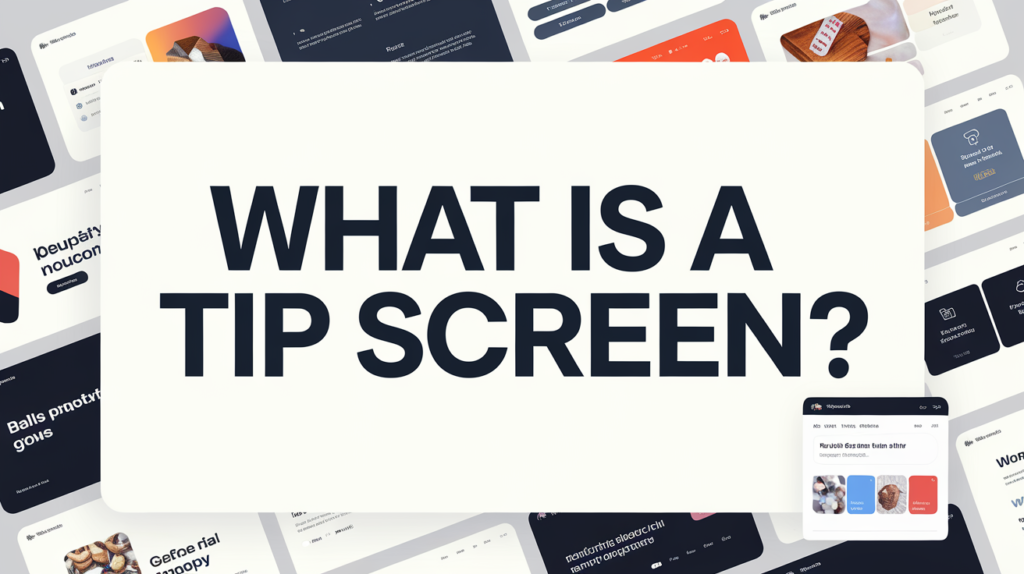Understanding the Tip Screen: A Guide to How It Works and Why It Matters

In today’s world, you’ve probably seen a “tip screen” during a payment process. Whether you’re ordering coffee, getting a haircut, or paying for food delivery, tip screens are everywhere. But do you really know how they work or why they are important?
This blog will explain everything you need to know about these tools in a simple, easy-to-understand way. Let’s take a step-by-step approach to understanding a tipping screen, how it works, and why businesses use it.
Read More About Janitorai
What is a Tip Screen?
A tipping screen is a part of the payment process that asks you if you’d like to leave a tip for the service or product you’ve received. It usually appears on a payment device, like a card reader or touchscreen, after you’ve made a purchase.
These screens are mostly seen in restaurants, cafes, salons, and even ride-hailing apps. Instead of giving cash tips, you can now tip using a card or mobile payment. The tipping option offers preset choices, like 10%, 15%, or 20%, but you can also choose your own amount.

How Do Tip Screens Work?
These modern payment features are built into advanced systems. Here’s how they work step by step:
Transaction Begins
After your purchase is scanned or entered, the payment screen shows the total amount you owe.
Tipping Options Appear
Once you swipe your card or tap your phone to pay, the tipping screen pops up. It will show several tip percentages or a “custom tip” option. Sometimes, there’s even a “no tip” button.
You Select an Option
You press a button to select how much to tip. The system then adds the tip to your total payment.
Payment is Processed
After adding the tip, the final amount is charged to your card or mobile wallet.
Why Are Tip Screens Used?
Businesses use tipping screens to make tipping easier for customers and employees. Here are some reasons why they’re so popular:
- Convenience for Customers
- You don’t need to carry cash anymore. These tools allow you to tip directly through your card or mobile payment.
- Fair Pay for Workers
- Many workers in the service industry rely on tips to earn a decent income. This system ensures they receive fair compensation.
- Encourages Tipping
- The presence of tipping options reminds you to consider tipping, which helps workers earn more.
- Saves Time
- Tipping on a screen is faster than counting cash or coins, which speeds up the payment process for everyone.
Learn More About Best Power Waxers
Where Are Tipping Screens Commonly Found?
You’ll find these payment tools in many places. Here are some common examples:
- Restaurants and Cafes
- When you pay for your meal or coffee, the payment option asks if you’d like to reward the staff for their service.
- Food Delivery Services
- Apps like Uber Eats or DoorDash use tipping prompts to let you tip delivery drivers.
- Salons and Barbershops
- After getting a haircut or beauty service, the system allows you to thank your stylist.
- Rideshare Apps
- Platforms like Lyft or Uber let you tip drivers after a trip using a virtual tool.
- Retail Stores
- In some cases, stores with personalized services, like bakeries or boutique shops, may use these screens.
What Are the Benefits of Tipping Screens?
These systems have advantages for both customers and businesses. Let’s take a closer look:
For Customers
- Simple and Fast: It’s easy to add a tip with just a tap—no need to fumble with cash or change.
- Customizable Options: You can choose from preset amounts or type in your tip.
- Secure Transactions: Digital payments are safer than carrying cash.
For Businesses
- Improved Employee Morale: Workers feel valued when they receive tips, which boosts their motivation.
- Increased Revenue: Tipping systems encourage more tipping, which benefits both employees and businesses.
- Streamlined Payments: Digital tipping speeds up the checkout process, reducing wait times.
Also, read About Geometry Spot
Why Do Some People Feel Awkward Using These Systems?
While these tools are convenient, some people find them uncomfortable. Here’s why:
- Pressure to Tip
- Tipping screens are very visible, especially when workers or other customers are nearby. This can make you feel pressured to tip even if you don’t want to.
- Confusing Options
- Sometimes, the preset tip percentages can feel too high or unclear. For instance, tipping 20% on a $5 coffee might not make sense to you.
- Cultural Differences
- In some cultures, tipping isn’t common, so using such systems might feel strange or unnecessary.
How Can You Use These Tools Comfortably?
If you ever feel unsure about using a tipping system, here are some tips to make it easier:
- Set a Tipping Budget
- Decide how much you’re willing to tip ahead of time. This way, you won’t feel pressured on the spot.
- Understand the Service
- Think about the quality of service you received. A good tip is a way to show appreciation.
- Ask Questions
- If you have any questions about the tipping system, don’t hesitate to ask the staff or cashier.
- Choose What’s Right for You
- Remember, tipping is optional. You can always choose the “no tip” option if you don’t feel it’s necessary.
The Future of Tip Screens
These tools are becoming more advanced. In the future, you might see more personalized options, like tips-based AI-based automatic tipping suggestions for evious tipping habits. Some apps are also experimenting with automatic tipping suggestions based on AI.
Additionally, as more people use digital wallets like Apple Pay or Google Pay, tipping systems will likely become even more common. Businesses will continue to rely on them as cash payments decrease.
Read More About Youtube To MP4 Converter
Are These Tools Fair?
The fairness of tipping systems is often debated. On one hand, they provide workers with more opportunities to earn tips. On the other hand, some people believe businesses should pay higher wages instead of relying on tips.
It’s important to remember that tipping is a personal choice. These tools are simply there to make the process easier, but they don’t force you to tip.
Conclusion
Tip screens have changed the way we tip, making it faster and easier than ever before. They benefit both customers and workers by simplifying the process and ensuring service staff receive fair pay. While they’re not perfect, you can use them in a way that feels comfortable for you.
By understanding how these systems work and why they’re used, you can make informed decisions the next time you encounter one. Whether you’re grabbing a coffee, paying for a ride, or ordering food, tipping systems are here to stay—and they’re shaping the future of tipping.
